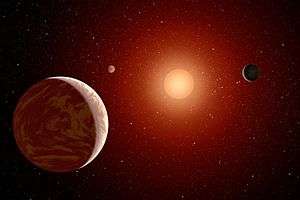Gliese 163
| Observation data Epoch J2000 Equinox J2000 | |
|---|---|
| Constellation | Dorado |
| Right ascension | 04h 09m 15.663s |
| Declination | −53° 22′ 25.31″ |
| Apparent magnitude (V) | 11.8 |
| Characteristics | |
| Spectral type | M3.5V |
| Astrometry | |
| Absolute magnitude (MV) | 10.9 |
| Other designations | |
| Details | |
| Mass | 0.40 ± 0.02[1] M☉ |
| Temperature | 3500 ± 100[1] K |
| Metallicity [Fe/H] | 0.1 ± 0.1[1] dex |
| Rotation | 61.0±0.3 d[2] |
| Age | 0.77 ± 0.03[1] Gyr |
| Database references | |
| SIMBAD | data |
Gliese 163 is an M3.5V red dwarf located 49 light years (15.0pc) from the sun, in the constellation Dorado.[3] Its coordinates in the night sky are RA 04h 9m 16s and Dec. -53°22'. It has a visual magnitude of 11.8 and an absolute magnitude of 10.9.[3] Other stellar catalog names for it include HIP 19394 and LHS 188.
Planetary system
In September 2012, astronomers using the HARPS instrument announced the discovery of two planets orbiting Gliese 163.[4][5] One planet, Gliese 163 c, with an orbital period of 26 days, and a minimum mass of 7.2 Earth masses, was considered potentially in the habitable zone, although hotter than Earth. A second planet, Gliese 163 b, was also announced, with a period of 1 day. It would be too hot to be considered habitable. Evidence was also found for a third planet orbiting further out than c and b.[4][5] In June 2013, it was concluded that at least 3 planets orbit around the star with fourth planet being a possibility.[6]
| Companion (in order from star) |
Mass | Semimajor axis (AU) |
Orbital period (days) |
Eccentricity | Inclination | Radius |
|---|---|---|---|---|---|---|
| b | 0.0334 ± 0.0019 MJ | 0.06069 ± 0.0001 | 8.633 ± 0.00155 | 0.0106 ± 0.05 | — | — |
| e | 0.012 MJ | 0.10 | 19.46 ± 0.02 | 0.32 ± 0.17 | — | — |
| c | 6.8 M⊕ | 0.1254 ± 0.0001 | 25.645 ± 0.0235 | 0.094 ± 86[~ 1] | — | — |
| f | 0.023 MJ | 0.33 | 108.4 ± 0.5 | 0.41 ± 0.15 | — | — |
| d | 0.06945 ± 0.0092 MJ | 1.02689 ± 0.0086 | 600.895 ± 7.56 | 0.399 ± 0.077 | — | — |
Notes
- ↑ So at http://exoplanet.eu/, but eccentricity of an elliptic orbit cannot be equal or exceed 1. (Maybe 0.094 ± 0.086 ?) (At Bonfils et al. (2013), Table 2: 0.099 ± 0.086).
References
- 1 2 3 4 http://arxiv.org/pdf/1306.1717.pdf
- ↑ Suárez Mascareño, A.; et al. (September 2015), "Rotation periods of late-type dwarf stars from time series high-resolution spectroscopy of chromospheric indicators", Monthly Notices of the Royal Astronomical Society, 452 (3): 2745−2756, arXiv:1506.08039
 , Bibcode:2015MNRAS.452.2745S, doi:10.1093/mnras/stv1441.
, Bibcode:2015MNRAS.452.2745S, doi:10.1093/mnras/stv1441. - 1 2 Staff (September 20, 2012). "LHS 188 -- High proper-motion Star". Centre de données astronomiques de Strasbourg (Strasbourg astronomical Data Center). Retrieved September 20, 2012.
- 1 2 Méndez, Abel (August 29, 2012). "A Hot Potential Habitable Exoplanet around Gliese 163". University of Puerto Rico at Arecibo (Planetary Habitability Laboratory). Retrieved September 20, 2012.
- 1 2 Redd, Nola Taylor (September 20, 2012). "Newfound Alien Planet a Top Contender to Host Life". Space.com. Retrieved September 20, 2012.
- ↑ http://arxiv.org/abs/1306.1717
- ↑ "Planet Gj 163 b". Extrasolar Planets Encyclopaedia. Retrieved 2013-06-15.
- ↑ "Planet Gj 163 c". Extrasolar Planets Encyclopaedia. Retrieved 2013-06-15.
- ↑ "Planet Gj 163 d". Extrasolar Planets Encyclopaedia. Retrieved 2013-06-15.
- ↑ Bonfils, X.; Lo Curto, G.; Correia, A. C. M.; Laskar, J.; Udry, S.; Delfosse, X.; Forveille, T.; Astudillo-Defru, N.; Benz, W.; Bouchy, F.; Gillon, M.; Hébrard, G.; Lovis, C.; Mayor, M.; Moutou, C.; Naef, D.; Neves, V.; Pepe, F.; Perrier, C.; Queloz, D.; Santos, N. C.; Ségransan, D. (5 August 2013). "The HARPS search for southern extra-solar planets". Astronomy & Astrophysics. 556: A110. doi:10.1051/0004-6361/201220237.
